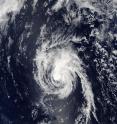NASA sees Tropical Storm Lester moving away from Hawaiian islands
Tropical Storm Lester passed the Hawaiian Islands over the holiday weekend of Sept 4 through 6 and NASA's Aqua satellite captured an image of the weakening storm over 900 miles away from Honolulu. The Moderate Resolution Imaging Spectroradiometer or MODIS instrument aboard NASA's Aqua satellite captured a visible image of Tropical Storm Lester in the Central Pacific on Sept. 6 at 00:10 UTC (Sept. 5 at 8:10 p.m. EDT/2 p.m. HST). The image showed a concentration of clouds and storms around the center of circulation, but the western quadrant was devoid of strong thunderstorms. NOAA's GOES-15 imagery continues to show Tropical Storm Lester with a partly exposed low-level circulation center.
Since the MODIS image, NOAA's Central Pacific Hurricane Center noted "The higher cloud tops have rotated around to the west side of the system."
At 11 a.m. EDT (500 a.m. HST/1500 UTC), the center of Tropical Storm Lester was located near 33.2 degrees north latitude and 166.0 degrees west longitude, about 960 miles (1,545 km) north-northwest of Honolulu, Hawaii.
NOAA's Central Pacific Hurricane Center (CPHC) said Lester is moving toward the north near 12 mph (19 kph) and this motion will continue through the day today. The cyclone will turn toward the northeast on Wednesday with an increase in forward speed.
Maximum sustained winds are near 60 mph (95 kph) with higher gusts. The estimated minimum central pressure is 999 millibars.
Some weakening is forecast during the next 48 hours as Lester transitions to a post-tropical low.
For updated forecasts on Lester, visit the CPHC website: http://www.prh.noaa.gov/cphc
Source: NASA/Goddard Space Flight Center
Articles on the same topic
- NASA sees remnants of Tropical Cyclone Newton over Southwestern USThu, 8 Sep 2016, 16:07:06 UTC
- NASA sees a much weaker Tropical Storm LesterThu, 8 Sep 2016, 16:06:42 UTC
Other sources
- NASA sees remnants of Tropical Cyclone Newton over Southwestern USfrom PhysorgThu, 8 Sep 2016, 16:01:42 UTC
- NASA sees a much weaker Tropical Storm Lesterfrom PhysorgWed, 7 Sep 2016, 18:01:31 UTC
- NASA sees Tropical Storm Lester moving away from Hawaiian islandsfrom PhysorgTue, 6 Sep 2016, 19:25:43 UTC
